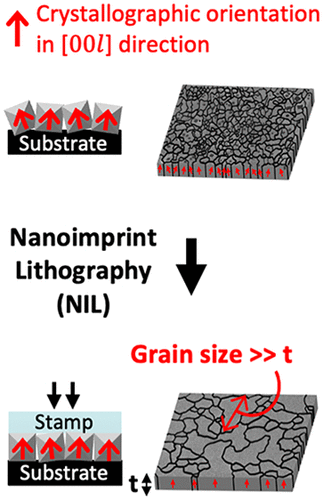当前位置:
X-MOL 学术
›
ACS Appl. Mater. Interfaces
›
论文详情
Our official English website, www.x-mol.net, welcomes your
feedback! (Note: you will need to create a separate account there.)
Surface Energy-Driven Preferential Grain Growth of Metal Halide Perovskites: Effects of Nanoimprint Lithography Beyond Direct Patterning
ACS Applied Materials & Interfaces ( IF 8.3 ) Pub Date : 2021-01-21 , DOI: 10.1021/acsami.0c17655 Jiyoung Moon 1 , Sunah Kwon 1 , Masoud Alahbakhshi 2 , Yeonghun Lee 1 , Kyeongjae Cho 1 , Anvar Zakhidov 3, 4 , Moon J. Kim 1 , Qing Gu 2
ACS Applied Materials & Interfaces ( IF 8.3 ) Pub Date : 2021-01-21 , DOI: 10.1021/acsami.0c17655 Jiyoung Moon 1 , Sunah Kwon 1 , Masoud Alahbakhshi 2 , Yeonghun Lee 1 , Kyeongjae Cho 1 , Anvar Zakhidov 3, 4 , Moon J. Kim 1 , Qing Gu 2
Affiliation

|
Hybrid organic–inorganic lead halide perovskites have attracted much attention in the field of optoelectronic devices because of their desirable properties such as high crystallinity, smooth morphology, and well-oriented grains. Recently, it was shown that thermal nanoimprint lithography (NIL) is an effective method not only to directly pattern but also to improve the morphology, crystallinity, and crystallographic orientations of annealed perovskite films. However, the underlining mechanisms behind the positive effects of NIL on perovskite material properties have not been understood. In this work, we study the kinetics of perovskite grain growth with surface energy calculations by first-principles density functional theory (DFT) and reveal that the surface energy-driven preferential grain growth during NIL, which involves multiplex processes of restricted grain growth in the surface-normal direction, abnormal grain growth, crystallographic reorientation, and grain boundary migration, is the enabler of the material quality enhancement. Moreover, we develop an optimized NIL process and prove its effectiveness by employing it in a perovskite light-emitting electrochemical cell (PeLEC) architecture, in which we observe a fourfold enhancement of maximum current efficiency and twofold enhancement of luminance compared to a PeLEC without NIL, reaching a maximum current efficiency of 0.07598 cd/A at 3.5 V and luminance of 1084 cd/m2 at 4 V.
中文翻译:

金属卤化物钙钛矿的表面能驱动优先晶粒生长:纳米压印光刻技术的作用超出直接图案化
杂化有机-无机卤化铅钙钛矿因其所需的特性(例如高结晶度,光滑的形态和良好取向的晶粒)而在光电器件领域引起了广泛关注。近来,已经显示出热纳米压印光刻法(NIL)不仅是直接图案化而且改善退火的钙钛矿膜的形态,结晶度和结晶学取向的有效方法。但是,尚未了解NIL对钙钛矿材料性能产生积极影响的潜在机制。在这项工作中,我们通过第一原理密度泛函理论(DFT)通过表面能计算研究了钙钛矿晶粒生长的动力学,并揭示了NIL期间表面能驱动的优先晶粒生长,它涉及到限制材料在表面法线方向上生长,异常晶粒生长,晶体学重新定向和晶界迁移的多重过程,是提高材料质量的原因。此外,我们开发了一种优化的NIL工艺,并通过将其用于钙钛矿发光电化学电池(PeLEC)体系结构来证明其有效性,与没有NIL的PeLEC相比,在该结构中,我们观察到最大电流效率提高了四倍,亮度提高了两倍。 ,在3.5 V和亮度1084 cd / m时达到的最大电流效率为0.07598 cd / A2在4 V下。
更新日期:2021-02-03
中文翻译:

金属卤化物钙钛矿的表面能驱动优先晶粒生长:纳米压印光刻技术的作用超出直接图案化
杂化有机-无机卤化铅钙钛矿因其所需的特性(例如高结晶度,光滑的形态和良好取向的晶粒)而在光电器件领域引起了广泛关注。近来,已经显示出热纳米压印光刻法(NIL)不仅是直接图案化而且改善退火的钙钛矿膜的形态,结晶度和结晶学取向的有效方法。但是,尚未了解NIL对钙钛矿材料性能产生积极影响的潜在机制。在这项工作中,我们通过第一原理密度泛函理论(DFT)通过表面能计算研究了钙钛矿晶粒生长的动力学,并揭示了NIL期间表面能驱动的优先晶粒生长,它涉及到限制材料在表面法线方向上生长,异常晶粒生长,晶体学重新定向和晶界迁移的多重过程,是提高材料质量的原因。此外,我们开发了一种优化的NIL工艺,并通过将其用于钙钛矿发光电化学电池(PeLEC)体系结构来证明其有效性,与没有NIL的PeLEC相比,在该结构中,我们观察到最大电流效率提高了四倍,亮度提高了两倍。 ,在3.5 V和亮度1084 cd / m时达到的最大电流效率为0.07598 cd / A2在4 V下。











































 京公网安备 11010802027423号
京公网安备 11010802027423号